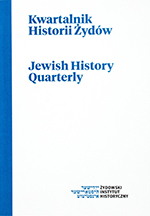Słowne i ikoniczne reprezentacje motywu księgi/książki na nagrobkach żydowskich w Polsce
Verbal and Iconic Representations of Book Motifs on Jewish Tombstones in Poland
Author(s): Andrzej TrzcińskiSubject(s): Social history, History of Judaism
Published by: Żydowski Instytut Historyczny
Keywords: Jewish cemeteries; Jewish tombstones; sepulchral images; iconology; book
Summary/Abstract: The principal source materials are inscriptions and figurative images on Jewish tombstones in the historic areas of the Polish Republic from the 13th to the 21st century. The verbal representations were present throughout that period while the iconic ones were only added at the beginning of the 19th century. The former include such terms used in the inscriptions as the Sefer Tora (the book of Torah), Torah (in the full range of its meanings) and sefer (‘book”), along with numerous examples of a narrower scope, from more general ones, e.g. sidur (‘prayer book) to the titles of specific works. The latter are represented by the motif of ‘Torah scrolls’ in the form used in synagogue literature, and ‘the book’—in the form known since Gutenberg’s times—both placed in a variety of contexts. While the list of verbal and iconic motifs may be of modest length, a skilful combination of them and their use in the context of traditional cultural codes convey quite a wealth of meanings. An analysis of the materials makes it possible to draw several general conclusions: (1) The Book has been a very important element of Jewish tradition and culture since the biblical times to the present day, heavily used also on Jewish tombstones since the Middle Ages. (2) The relatively late appearance of the representation of the Torah strolls and the book in Jewish tomb images has been associated with the broader practice of introducing in the early 19th century of threads that had not been used before, leading to a widening of the scope of motifs by more specialized ones, with narrower meanings. In the earlier period, the symbolic representation of the Torah included two motifs with multiple meanings: the tree of life and the crown. (3) Throughout the period reviewed here, the contents are predominantly male-oriented, which follows first of all from the traditional imperative for men to study the Torah. (4) The predominant area the content thus encoded were references to traditional religious life. In many epitaphs we come across quotations or references to phrases from writings such as the Bible, the Talmud, the halachic compendia or prayers. (5) Since the 19th century, in bigger towns, in progressive and assimilating milieux, the book motif vas been used to convey lay messages, ensuing from changes in culture and customs.
Journal: Kwartalnik Historii Żydów
- Issue Year: 275/2020
- Issue No: 03
- Page Range: 509-550
- Page Count: 42
- Language: Polish

